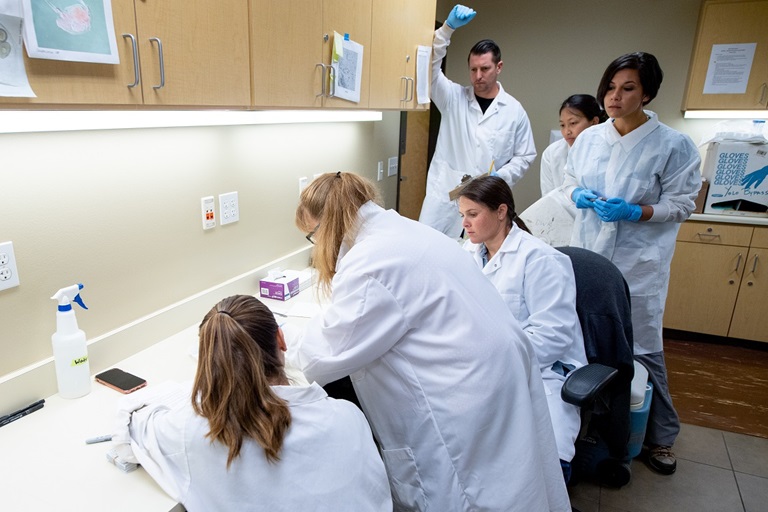Operation smelt recovery: Protecting endangered fish in the Delta
DWR scientists dissect Delta smelt as part of a study to monitor the effects of introducing hatchery smelt into the wild. DWR/2019
About seven miles north of Rio Vista in Yolo County, DWR’s Sentinel research vessel gently approaches the underwater cages. DWR researchers snap into action, lifting the large black steel enclosures from the muddy water and guiding them with a hydraulic crane onto the ship’s deck. Inside each metal cage is precious cargo: a school of Delta smelt, the region’s most delicate and endangered fish, gleaming in inches of water.
Nicole Kwan, a DWR Environmental Scientist and field lead for the project, unlatched the first cage and peeked inside. “We definitely have survivors!” she announced.
That scene culminated a four-week study that placed 360 hatchery-born Delta smelt in underwater cages in a deep-water shipping channel off the Sacramento River. As numbers of Delta smelt continue to plummet, scientists are considering whether hatchery-born smelt should be introduced into the wild by first acclimating them to Delta river water in porous metal enclosures. It’s an early-stage idea, but conclusions drawn from this pilot study could help save the finger-length, translucent fish from extinction.
While placing salmon in underwater cages in rivers is a common practice for studies related to fish growth, the method has never been attempted with Delta smelt. About 25,000 Delta smelt currently reside in hatcheries. The pilot study set out to answer whether these hatchery-raised fish would survive in the wild.
On March 27, DWR environmental scientists lifted the tiny fish from the water for inspection and found that more than 98 percent survived. To understand and explain the success, scientists thoroughly evaluated each smelt’s overall growth and health, and dissected their stomachs to examine food content.
“The study was designed to better understand what may happen to the species as a whole,” explained Melinda Baerwald, DWR Environmental Program Manager and study co-leader. “Because wild Delta smelt are so rare, this type of study will allow us to use hatchery fish to uncover answers that we wouldn’t otherwise be able to get.”
The study had two primary goals: 1) to advance the conversation of introducing hatchery-raised smelt into the wild and 2) create a new tool to test the effectiveness of DWR’s tidal restoration sites and other water management efforts aimed at improving conditions for Delta smelt.
The Delta is home to so few smelt that last year – for the first time on record – an annual trawling survey captured zero. Up until a couple of decades ago, hundreds of Delta smelt would turn up in the same survey. But the amount of Delta smelt have steadily declined from an array of man-made causes.
To boost endangered smelt populations, DWR has designed several projects to increase habitat and available food. In 2018, the department broke ground on four tidal restoration sites, each sharing the goal of creating conditions to help smelt thrive. Scientists can measure the fish food – small aquatic bugs known as zooplankton – that grow as the tides slosh in and out of the restoration site. By placing captive smelt at the restoration sites, scientists will be able to check whether the site provides adequate food for smelt to survive.
DWR doesn’t have the authority to decide whether smelt should ultimately be repopulated into the Delta using cages. That determination would fall on the U.S. Fish and Wildlife Service and the California Department of Fish and Wildlife, the respective federal and state agencies that permitted the DWR smelt enclosure study.
Brian Schreier, DWR Senior Environmental Scientist and study co-leader, said the study is a critical milestone toward advancing understanding about how to save endangered Delta fish. So far, he said, the results look good.
“We’re focused on developing a tool for utilizing hatchery smelt in the wild,” Schreier said. “The end game is to bolster wild smelt populations to prevent extinction.”
About 20 DWR scientists were involved in the study, with support from UC Davis and other agency researchers. DWR plans to replicate its enclosure experiment in different Delta habitats in late summer and fall 2019 to further evaluate conditions to help smelt thrive.
